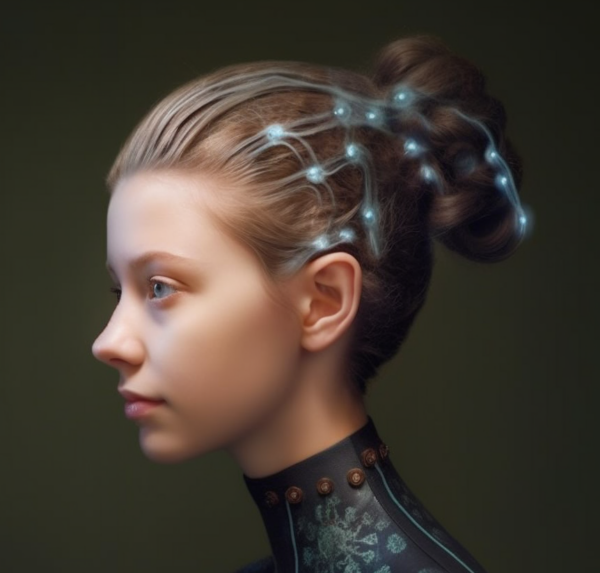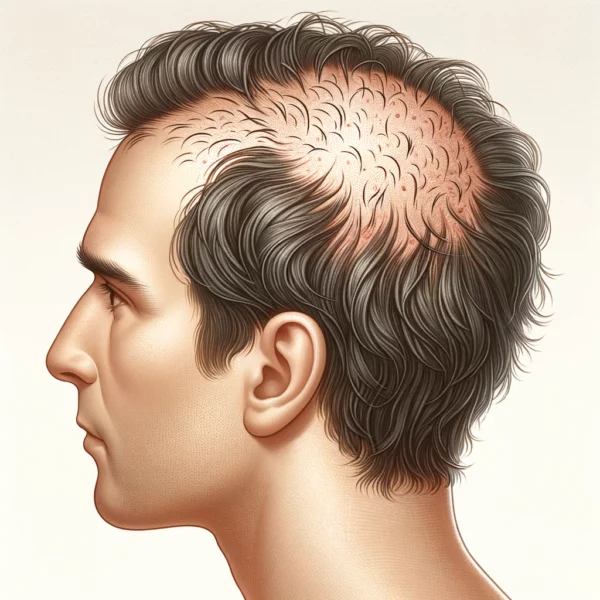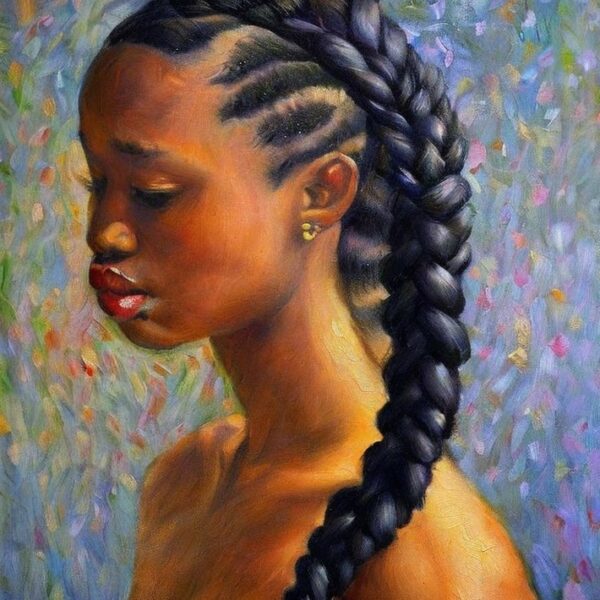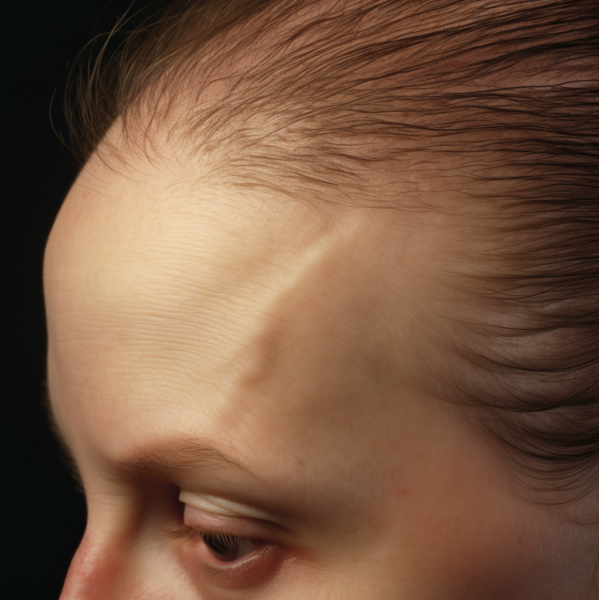In the world of fashion and beauty, trends often come with an unexpected sting in their tail. One such is the ‘Croydon facelift’, a hairstyle which, while providing an instant “lift” effect to the face, may also cause damage in the long run. It’s a style sometimes adopted by celebrities and supermodels, but the consequences aren’t quite as glamorous as the people sporting them might think.
The Croydon facelift, also referred to as a Millie facelift depending on the regional vernacular, is a hairstyle where the hair is pulled back tightly and tied in a bun or ponytail at the back. The result is a lift effect on the skin of the forehead and face. This hairstyle has its origin in the culture of the working-class British youth and subcultures. Though these days it has found its place in mainstream fashion, it’s essential to understand the risks that come with it, most significantly traction alopecia.
Traction alopecia, a term first coined in a 1958 study by Dr Albert H. Slepyan, refers to gradual hair loss caused by hairstyles that tightly pull the hair. In the case of the Croydon facelift, the hair is pulled back so tightly that the skin on the face appears taut, mimicking a surgical facelift. However, if this traction on the scalp is persistent and prolonged it can cause inflammation in and around the hair follicles, this results in tissue damage leading to hair loss over time.
Despite repeated warnings from dermatologists, this hairstyle has gained popularity, not just amongst the youth, but also in the celebrity realm. Celebrities are often seen as trendsetters, but it’s crucial to remember that what works for them may not be suitable for everyone. Hairstyles like the Croydon facelift can cause lasting damage, regardless of the temporary aesthetic benefits they provide.
An interesting anecdote is that the Croydon facelift isn’t a new phenomenon by any means. The trend can be traced back to ancient Egypt, where Queen Nefertiti reportedly wore a similar hairstyle. Queen Nefertiti lived between 1370 BCE and 1330 BCE and the name Nefert-iti means ‘the Beautiful One Has Come’ so it seems she had a reputation to live up to. Despite the derogatory undertones associated with the term Croydon facelift today, this hairstyle form has indeed stood the test of time and perhaps was considered in a rather more positive light 3300 years ago. Whether Queen Nefertiti experienced traction alopecia isn’t known, but it is likely if she continued to wear this hairstyle for a prolonged period of time.
So, what can be done? Prevention is the best strategy. Avoid pulling hair back tightly for extended periods. One indication that a ponytail is too tight is a sensation of pain in the scalp skin, particularly at the hairline. Embrace hairstyles that don’t put excessive strain on hair follicles. And most importantly, “listen” to your scalp. If a hairstyle causes discomfort or pain, it’s a clear sign that it could be causing harm.
However, if you’re already experiencing hair loss due to traction alopecia, don’t despair. There are some treatments available today that can help reverse or manage the condition, such as topical minoxidil, corticosteroids, or even hair transplants in severe cases. Always consult a dermatologist for personalized advice dependent on your particular situation.
In conclusion, while the Croydon facelift might offer a short-term ‘lift’ effect, the long-term damage it can cause to your hair health probably isn’t worth the fleeting aesthetic appeal. Choosing hairstyles wisely, embraces beauty practices that not only make us look good but also ensure we remain healthy. Fashion and health can go hand in hand, ensuring a happier and more confident you.
Bibliography
11711645 {11711645:QXXR9JMG},{11711645:XF3RS5IN},{11711645:7MNZ3C6I},{11711645:XMUG6M7R},{11711645:ZF6EHPUW},{11711645:R4G5X53N},{11711645:DTN3KNZS},{11711645:I64BNKJ8},{11711645:6J7DPRQM} 1 vancouver 50 date asc 328 https://www.keratin.com/wp-content/plugins/zotpress/ %7B%22status%22%3A%22success%22%2C%22updateneeded%22%3Afalse%2C%22instance%22%3Afalse%2C%22meta%22%3A%7B%22request_last%22%3A0%2C%22request_next%22%3A0%2C%22used_cache%22%3Atrue%7D%2C%22data%22%3A%5B%7B%22key%22%3A%22R4G5X53N%22%2C%22library%22%3A%7B%22id%22%3A11711645%7D%2C%22meta%22%3A%7B%22creatorSummary%22%3A%22Slepyan%22%2C%22parsedDate%22%3A%221958-09%22%2C%22numChildren%22%3A0%7D%2C%22bib%22%3A%22%26lt%3Bdiv%20class%3D%26quot%3Bcsl-bib-body%26quot%3B%20style%3D%26quot%3Bline-height%3A%201.35%3B%20%26quot%3B%26gt%3B%5Cn%20%20%26lt%3Bdiv%20class%3D%26quot%3Bcsl-entry%26quot%3B%20style%3D%26quot%3Bclear%3A%20left%3B%20%26quot%3B%26gt%3B%5Cn%20%20%20%20%26lt%3Bdiv%20class%3D%26quot%3Bcsl-left-margin%26quot%3B%20style%3D%26quot%3Bfloat%3A%20left%3B%20padding-right%3A%200.5em%3B%20text-align%3A%20right%3B%20width%3A%201em%3B%26quot%3B%26gt%3B1.%26lt%3B%5C%2Fdiv%26gt%3B%26lt%3Bdiv%20class%3D%26quot%3Bcsl-right-inline%26quot%3B%20style%3D%26quot%3Bmargin%3A%200%20.4em%200%201.5em%3B%26quot%3B%26gt%3BSlepyan%20AH.%20Traction%20alopecia.%20AMA%20Arch%20Derm.%201958%20Sep%3B78%283%29%3A395%26%23x2013%3B8.%26lt%3B%5C%2Fdiv%26gt%3B%5Cn%20%20%20%26lt%3B%5C%2Fdiv%26gt%3B%5Cn%26lt%3B%5C%2Fdiv%26gt%3B%22%2C%22data%22%3A%7B%22itemType%22%3A%22journalArticle%22%2C%22title%22%3A%22Traction%20alopecia%22%2C%22creators%22%3A%5B%7B%22creatorType%22%3A%22author%22%2C%22firstName%22%3A%22A.%20H.%22%2C%22lastName%22%3A%22Slepyan%22%7D%5D%2C%22abstractNote%22%3A%22%22%2C%22date%22%3A%221958-09%22%2C%22language%22%3A%22eng%22%2C%22DOI%22%3A%2210.1001%5C%2Farchderm.1958.01560090111025%22%2C%22ISSN%22%3A%220096-5359%22%2C%22url%22%3A%22%22%2C%22collections%22%3A%5B%223B2QDF7M%22%5D%2C%22dateModified%22%3A%222023-07-04T16%3A39%3A31Z%22%7D%7D%2C%7B%22key%22%3A%226J7DPRQM%22%2C%22library%22%3A%7B%22id%22%3A11711645%7D%2C%22meta%22%3A%7B%22creatorSummary%22%3A%22Rollins%22%2C%22parsedDate%22%3A%221961-05%22%2C%22numChildren%22%3A0%7D%2C%22bib%22%3A%22%26lt%3Bdiv%20class%3D%26quot%3Bcsl-bib-body%26quot%3B%20style%3D%26quot%3Bline-height%3A%201.35%3B%20%26quot%3B%26gt%3B%5Cn%20%20%26lt%3Bdiv%20class%3D%26quot%3Bcsl-entry%26quot%3B%20style%3D%26quot%3Bclear%3A%20left%3B%20%26quot%3B%26gt%3B%5Cn%20%20%20%20%26lt%3Bdiv%20class%3D%26quot%3Bcsl-left-margin%26quot%3B%20style%3D%26quot%3Bfloat%3A%20left%3B%20padding-right%3A%200.5em%3B%20text-align%3A%20right%3B%20width%3A%201em%3B%26quot%3B%26gt%3B1.%26lt%3B%5C%2Fdiv%26gt%3B%26lt%3Bdiv%20class%3D%26quot%3Bcsl-right-inline%26quot%3B%20style%3D%26quot%3Bmargin%3A%200%20.4em%200%201.5em%3B%26quot%3B%26gt%3BRollins%20TG.%20Traction%20follicultis%20with%20hair%20casts%20and%20alopecia.%20Am%20J%20Dis%20Child.%201961%20May%3B101%3A639%26%23x2013%3B40.%26lt%3B%5C%2Fdiv%26gt%3B%5Cn%20%20%20%26lt%3B%5C%2Fdiv%26gt%3B%5Cn%26lt%3B%5C%2Fdiv%26gt%3B%22%2C%22data%22%3A%7B%22itemType%22%3A%22journalArticle%22%2C%22title%22%3A%22Traction%20follicultis%20with%20hair%20casts%20and%20alopecia%22%2C%22creators%22%3A%5B%7B%22creatorType%22%3A%22author%22%2C%22firstName%22%3A%22T.%20G.%22%2C%22lastName%22%3A%22Rollins%22%7D%5D%2C%22abstractNote%22%3A%22%22%2C%22date%22%3A%221961-05%22%2C%22language%22%3A%22eng%22%2C%22DOI%22%3A%2210.1001%5C%2Farchpedi.1961.04020060097013%22%2C%22ISSN%22%3A%220002-922X%22%2C%22url%22%3A%22%22%2C%22collections%22%3A%5B%223B2QDF7M%22%5D%2C%22dateModified%22%3A%222023-07-04T16%3A44%3A48Z%22%7D%7D%2C%7B%22key%22%3A%22XF3RS5IN%22%2C%22library%22%3A%7B%22id%22%3A11711645%7D%2C%22meta%22%3A%7B%22creatorSummary%22%3A%22Oz%5Cu00e7elik%22%2C%22parsedDate%22%3A%222005%22%2C%22numChildren%22%3A0%7D%2C%22bib%22%3A%22%26lt%3Bdiv%20class%3D%26quot%3Bcsl-bib-body%26quot%3B%20style%3D%26quot%3Bline-height%3A%201.35%3B%20%26quot%3B%26gt%3B%5Cn%20%20%26lt%3Bdiv%20class%3D%26quot%3Bcsl-entry%26quot%3B%20style%3D%26quot%3Bclear%3A%20left%3B%20%26quot%3B%26gt%3B%5Cn%20%20%20%20%26lt%3Bdiv%20class%3D%26quot%3Bcsl-left-margin%26quot%3B%20style%3D%26quot%3Bfloat%3A%20left%3B%20padding-right%3A%200.5em%3B%20text-align%3A%20right%3B%20width%3A%201em%3B%26quot%3B%26gt%3B1.%26lt%3B%5C%2Fdiv%26gt%3B%26lt%3Bdiv%20class%3D%26quot%3Bcsl-right-inline%26quot%3B%20style%3D%26quot%3Bmargin%3A%200%20.4em%200%201.5em%3B%26quot%3B%26gt%3BOz%26%23xE7%3Belik%20D.%20Extensive%20traction%20alopecia%20attributable%20to%20ponytail%20hairstyle%20and%20its%20treatment%20with%20hair%20transplantation.%20Aesthetic%20Plast%20Surg.%202005%3B29%284%29%3A325%26%23x2013%3B7.%26lt%3B%5C%2Fdiv%26gt%3B%5Cn%20%20%20%26lt%3B%5C%2Fdiv%26gt%3B%5Cn%26lt%3B%5C%2Fdiv%26gt%3B%22%2C%22data%22%3A%7B%22itemType%22%3A%22journalArticle%22%2C%22title%22%3A%22Extensive%20traction%20alopecia%20attributable%20to%20ponytail%20hairstyle%20and%20its%20treatment%20with%20hair%20transplantation%22%2C%22creators%22%3A%5B%7B%22creatorType%22%3A%22author%22%2C%22firstName%22%3A%22Derya%22%2C%22lastName%22%3A%22Oz%5Cu00e7elik%22%7D%5D%2C%22abstractNote%22%3A%22%22%2C%22date%22%3A%222005%22%2C%22language%22%3A%22eng%22%2C%22DOI%22%3A%2210.1007%5C%2Fs00266-005-0004-5%22%2C%22ISSN%22%3A%220364-216X%22%2C%22url%22%3A%22%22%2C%22collections%22%3A%5B%223B2QDF7M%22%5D%2C%22dateModified%22%3A%222023-07-04T16%3A43%3A55Z%22%7D%7D%2C%7B%22key%22%3A%22I64BNKJ8%22%2C%22library%22%3A%7B%22id%22%3A11711645%7D%2C%22meta%22%3A%7B%22creatorSummary%22%3A%22Fox%20et%20al.%22%2C%22parsedDate%22%3A%222007-01%22%2C%22numChildren%22%3A0%7D%2C%22bib%22%3A%22%26lt%3Bdiv%20class%3D%26quot%3Bcsl-bib-body%26quot%3B%20style%3D%26quot%3Bline-height%3A%201.35%3B%20%26quot%3B%26gt%3B%5Cn%20%20%26lt%3Bdiv%20class%3D%26quot%3Bcsl-entry%26quot%3B%20style%3D%26quot%3Bclear%3A%20left%3B%20%26quot%3B%26gt%3B%5Cn%20%20%20%20%26lt%3Bdiv%20class%3D%26quot%3Bcsl-left-margin%26quot%3B%20style%3D%26quot%3Bfloat%3A%20left%3B%20padding-right%3A%200.5em%3B%20text-align%3A%20right%3B%20width%3A%201em%3B%26quot%3B%26gt%3B1.%26lt%3B%5C%2Fdiv%26gt%3B%26lt%3Bdiv%20class%3D%26quot%3Bcsl-right-inline%26quot%3B%20style%3D%26quot%3Bmargin%3A%200%20.4em%200%201.5em%3B%26quot%3B%26gt%3BFox%20GN%2C%20Stausmire%20JM%2C%20Mehregan%20DR.%20Traction%20folliculitis%3A%20an%20underreported%20entity.%20Cutis.%202007%20Jan%3B79%281%29%3A26%26%23x2013%3B30.%26lt%3B%5C%2Fdiv%26gt%3B%5Cn%20%20%20%26lt%3B%5C%2Fdiv%26gt%3B%5Cn%26lt%3B%5C%2Fdiv%26gt%3B%22%2C%22data%22%3A%7B%22itemType%22%3A%22journalArticle%22%2C%22title%22%3A%22Traction%20folliculitis%3A%20an%20underreported%20entity%22%2C%22creators%22%3A%5B%7B%22creatorType%22%3A%22author%22%2C%22firstName%22%3A%22Gary%20N.%22%2C%22lastName%22%3A%22Fox%22%7D%2C%7B%22creatorType%22%3A%22author%22%2C%22firstName%22%3A%22Julie%20M.%22%2C%22lastName%22%3A%22Stausmire%22%7D%2C%7B%22creatorType%22%3A%22author%22%2C%22firstName%22%3A%22Darius%20R.%22%2C%22lastName%22%3A%22Mehregan%22%7D%5D%2C%22abstractNote%22%3A%22Traction%20folliculitis%20is%20a%20component%20of%20traction%20alopecia%20syndrome%20and%20has%20received%20minimal%20attention%20in%20primary%20source%20medical%20literature.%20The%20popularity%20of%20hairstyles%20that%20produce%20hair%20traction%20and%20the%20knowledge%20that%20early%20intervention%20improves%20prognosis%20amplify%20the%20importance%20of%20recognizing%20this%20entity.%20Traction%20folliculitis%20presents%20as%20perifollicular%20erythema%20and%20pustules%20on%20the%20scalp%20in%20areas%20where%20hairstyles%20produce%20traction%20on%20the%20hair%20shaft.%20In%20addition%20to%20the%20traction%2C%20concurrent%20hair%20care%20practices%20may%20play%20a%20facilitatory%20role%20in%20the%20development%20of%20traction%20folliculitis.%20Treatment%20involves%20immediate%20removal%20of%20traction%20on%20hair%20and%20temporary%20alteration%20of%20the%20facilitatory%20hair%20care%20practices.%20In%20more%20severe%20cases%2C%20topical%20or%20systemic%20antibacterial%20therapy%20and%2C%20occasionally%2C%20topical%20corticosteroid%20therapy%20may%20be%20necessary.%20Failure%20to%20discontinue%20traction-producing%20hairstyles%20can%20lead%20to%20traction%20alopecia%20and%20irreversible%20hair%20loss.%20Cultural%20considerations%20often%20are%20paramount%20in%20hairstyle%20choices%20and%20hair%20care%20practices%20that%20cause%20predisposition%20to%20traction%20disorders.%20Thus%2C%20culturally%20competent%20counseling%20requires%20understanding%20the%20significance%20of%20the%20hairstyle%20and%20hair%20care%20practices%20to%20the%20patient%20%28or%20caregivers%29%2C%20discussing%20the%20recommendations%20in%20a%20culturally%20sensitive%20manner%2C%20and%20negotiating%20mutually%20acceptable%20alternative%20practices.%22%2C%22date%22%3A%222007-01%22%2C%22language%22%3A%22eng%22%2C%22DOI%22%3A%22%22%2C%22ISSN%22%3A%220011-4162%22%2C%22url%22%3A%22%22%2C%22collections%22%3A%5B%223B2QDF7M%22%5D%2C%22dateModified%22%3A%222023-07-04T16%3A44%3A33Z%22%7D%7D%2C%7B%22key%22%3A%22XMUG6M7R%22%2C%22library%22%3A%7B%22id%22%3A11711645%7D%2C%22meta%22%3A%7B%22creatorSummary%22%3A%22Rucker%20Wright%20et%20al.%22%2C%22parsedDate%22%3A%222011-02%22%2C%22numChildren%22%3A0%7D%2C%22bib%22%3A%22%26lt%3Bdiv%20class%3D%26quot%3Bcsl-bib-body%26quot%3B%20style%3D%26quot%3Bline-height%3A%201.35%3B%20%26quot%3B%26gt%3B%5Cn%20%20%26lt%3Bdiv%20class%3D%26quot%3Bcsl-entry%26quot%3B%20style%3D%26quot%3Bclear%3A%20left%3B%20%26quot%3B%26gt%3B%5Cn%20%20%20%20%26lt%3Bdiv%20class%3D%26quot%3Bcsl-left-margin%26quot%3B%20style%3D%26quot%3Bfloat%3A%20left%3B%20padding-right%3A%200.5em%3B%20text-align%3A%20right%3B%20width%3A%201em%3B%26quot%3B%26gt%3B1.%26lt%3B%5C%2Fdiv%26gt%3B%26lt%3Bdiv%20class%3D%26quot%3Bcsl-right-inline%26quot%3B%20style%3D%26quot%3Bmargin%3A%200%20.4em%200%201.5em%3B%26quot%3B%26gt%3BRucker%20Wright%20D%2C%20Gathers%20R%2C%20Kapke%20A%2C%20Johnson%20D%2C%20Joseph%20CLM.%20Hair%20care%20practices%20and%20their%20association%20with%20scalp%20and%20hair%20disorders%20in%20African%20American%20girls.%20J%20Am%20Acad%20Dermatol.%202011%20Feb%3B64%282%29%3A253%26%23x2013%3B62.%26lt%3B%5C%2Fdiv%26gt%3B%5Cn%20%20%20%26lt%3B%5C%2Fdiv%26gt%3B%5Cn%26lt%3B%5C%2Fdiv%26gt%3B%22%2C%22data%22%3A%7B%22itemType%22%3A%22journalArticle%22%2C%22title%22%3A%22Hair%20care%20practices%20and%20their%20association%20with%20scalp%20and%20hair%20disorders%20in%20African%20American%20girls%22%2C%22creators%22%3A%5B%7B%22creatorType%22%3A%22author%22%2C%22firstName%22%3A%22Dakara%22%2C%22lastName%22%3A%22Rucker%20Wright%22%7D%2C%7B%22creatorType%22%3A%22author%22%2C%22firstName%22%3A%22Raechele%22%2C%22lastName%22%3A%22Gathers%22%7D%2C%7B%22creatorType%22%3A%22author%22%2C%22firstName%22%3A%22Alissa%22%2C%22lastName%22%3A%22Kapke%22%7D%2C%7B%22creatorType%22%3A%22author%22%2C%22firstName%22%3A%22Dayna%22%2C%22lastName%22%3A%22Johnson%22%7D%2C%7B%22creatorType%22%3A%22author%22%2C%22firstName%22%3A%22Christine%20L.%20M.%22%2C%22lastName%22%3A%22Joseph%22%7D%5D%2C%22abstractNote%22%3A%22BACKGROUND%3A%20Few%20studies%20have%20extensively%20examined%20the%20prevalence%20of%20hair%20care%20practices%20and%20their%20association%20with%20scalp%20and%20hair%20conditions%20in%20African%20American%20girls.%5CnOBJECTIVES%3A%20We%20sought%20to%20determine%20the%20prevalence%20of%20hair%20care%20practices%20and%20their%20association%20with%20traction%20alopecia%2C%20seborrheic%20dermatitis%20%28SD%29%2C%20and%20tinea%20capitis%20%28TC%29.%5CnMETHODS%3A%20A%20questionnaire%20was%20administered%20to%20caregivers%20of%20African%20American%20girls%20aged%201%20to%2015%20years.%20Multivariate%20analyses%20were%20performed%20to%20determine%20the%20association%20of%20hair%20care%20practices%20with%20reported%20disorders.%5CnRESULTS%3A%20A%20total%20of%20201%20surveys%20were%20completed%20from%20dermatology%20%28n%5Cu00a0%3D%2098%29%20and%20nondermatology%20%28n%5Cu00a0%3D%20103%29%20clinics.%20Mean%20patient%20age%20was%209.8%5Cu00a0%5Cu00b1%204.4%20years.%20Essentially%20all%20respondents%20reported%20use%20of%20hair%20oils%5C%2Fgrease%20%2899%25%29.%20Ponytails%2C%20braids%2C%20and%20cornrows%20were%20worn%20by%2081%25%2C%2067%25%2C%20and%2049%25%20of%20girls%2C%20respectively%2C%20within%20the%20past%2012%20months.%20In%20all%2C%2061%25%20reported%20hair%20washing%20every%202%20weeks%3B%2080%25%20used%20hot%20combs%3B%20and%2042%25%20used%20chemical%20relaxers.%20Cornrows%20were%20significantly%20related%20to%20traction%20alopecia%20among%20respondents%20from%20nondermatology%20clinics%20only%3A%20adjusted%20odds%20ratio%5Cu00a0%3D%205.79%20%2895%25%20CI%201.35-24.8%2C%20P%5Cu00a0%3D%20.018%29.%20Hair%20extensions%20and%20infrequent%20hair%20oil%20use%20were%20significantly%20related%20to%20SD%3A%20adjusted%20odds%20ratio%5Cu00a0%3D%202.37%20%2895%25%20CI%201.03-5.47%2C%20P%5Cu00a0%3D%20.04%29%20and%203.69%20%2895%25%20CI%201.07-12.7%2C%20P%5Cu00a0%3D%20.039%29%2C%20respectively.%20No%20significant%20associations%20were%20observed%20for%20TC.%5CnLIMITATIONS%3A%20Small%20sample%20size%20and%20disorders%20reported%20by%20caregivers%20were%20limitations.%5CnCONCLUSIONS%3A%20Certain%20hair%20care%20practices%20were%20strongly%20associated%20with%20development%20of%20traction%20alopecia%20and%20SD.%20No%20association%20was%20found%20between%20hair%20washing%20frequency%20and%20SD%20or%20TC%2C%20or%20between%20hair%20grease%20use%20and%20TC.%20These%20results%20can%20be%20used%20to%20inform%20practitioners%2C%20advise%20parents%2C%20and%20adapt%20treatment%20regimens%20to%20accommodate%20cultural%20preferences.%22%2C%22date%22%3A%222011-02%22%2C%22language%22%3A%22eng%22%2C%22DOI%22%3A%2210.1016%5C%2Fj.jaad.2010.05.037%22%2C%22ISSN%22%3A%221097-6787%22%2C%22url%22%3A%22%22%2C%22collections%22%3A%5B%223B2QDF7M%22%5D%2C%22dateModified%22%3A%222023-07-04T16%3A43%3A36Z%22%7D%7D%2C%7B%22key%22%3A%22DTN3KNZS%22%2C%22library%22%3A%7B%22id%22%3A11711645%7D%2C%22meta%22%3A%7B%22creatorSummary%22%3A%22Billero%20and%20Miteva%22%2C%22parsedDate%22%3A%222018%22%2C%22numChildren%22%3A0%7D%2C%22bib%22%3A%22%26lt%3Bdiv%20class%3D%26quot%3Bcsl-bib-body%26quot%3B%20style%3D%26quot%3Bline-height%3A%201.35%3B%20%26quot%3B%26gt%3B%5Cn%20%20%26lt%3Bdiv%20class%3D%26quot%3Bcsl-entry%26quot%3B%20style%3D%26quot%3Bclear%3A%20left%3B%20%26quot%3B%26gt%3B%5Cn%20%20%20%20%26lt%3Bdiv%20class%3D%26quot%3Bcsl-left-margin%26quot%3B%20style%3D%26quot%3Bfloat%3A%20left%3B%20padding-right%3A%200.5em%3B%20text-align%3A%20right%3B%20width%3A%201em%3B%26quot%3B%26gt%3B1.%26lt%3B%5C%2Fdiv%26gt%3B%26lt%3Bdiv%20class%3D%26quot%3Bcsl-right-inline%26quot%3B%20style%3D%26quot%3Bmargin%3A%200%20.4em%200%201.5em%3B%26quot%3B%26gt%3BBillero%20V%2C%20Miteva%20M.%20Traction%20alopecia%3A%20the%20root%20of%20the%20problem.%20Clin%20Cosmet%20Investig%20Dermatol.%202018%3B11%3A149%26%23x2013%3B59.%26lt%3B%5C%2Fdiv%26gt%3B%5Cn%20%20%20%26lt%3B%5C%2Fdiv%26gt%3B%5Cn%26lt%3B%5C%2Fdiv%26gt%3B%22%2C%22data%22%3A%7B%22itemType%22%3A%22journalArticle%22%2C%22title%22%3A%22Traction%20alopecia%3A%20the%20root%20of%20the%20problem%22%2C%22creators%22%3A%5B%7B%22creatorType%22%3A%22author%22%2C%22firstName%22%3A%22Victoria%22%2C%22lastName%22%3A%22Billero%22%7D%2C%7B%22creatorType%22%3A%22author%22%2C%22firstName%22%3A%22Mariya%22%2C%22lastName%22%3A%22Miteva%22%7D%5D%2C%22abstractNote%22%3A%22Traction%20alopecia%20%28TA%29%20affects%20one-third%20of%20women%20of%20African%20descent%20who%20wear%20various%20forms%20of%20traumatic%20hairstyling%20for%20a%20prolonged%20period%20of%20time.%20The%20risk%20of%20TA%20is%20increased%20by%20the%20extent%20of%20pulling%20and%20duration%20of%20traction%2C%20as%20well%20as%20the%20use%20of%20chemical%20relaxation.%20The%20frequent%20use%20of%20tight%20buns%20or%20ponytails%2C%20the%20attachment%20of%20weaves%20or%20hair%20extensions%2C%20and%20tight%20braids%20%28such%20as%20cornrows%20and%20dreadlocks%29%20are%20believed%20to%20be%20the%20highest%20risk%20hairstyles.%20TA%20can%20also%20occur%20in%20the%20setting%20of%20religious%20and%20occupational%20traumatic%20hairstyling.%20In%20its%20later%20stages%2C%20the%20disease%20may%20progress%20into%20an%20irreversible%20scarring%20alopecia%20if%20traumatic%20hairstyling%20continues%20without%20appropriate%20intervention.%20The%20most%20common%20clinical%20presentation%20includes%20marginal%20alopecia%20and%20non-marginal%20patchy%20alopecia.%20A%20clue%20to%20the%20clinical%20diagnosis%20is%20the%20preservation%20of%20the%20fringe%20sign%20as%20opposed%20to%20its%20loss%20in%20frontal%20fibrosing%20alopecia%20%28FFA%29.%20Dermoscopy%20can%20be%20helpful%20in%20the%20diagnosis%20and%20can%20detect%20the%20ongoing%20traction%20by%20the%20presence%20of%20hair%20casts.%20Histopathology%20can%20distinguish%20TA%20from%20alopecia%20areata%2C%20FFA%2C%20and%20patchy%20central%20centrifugal%20cicatricial%20alopecia.%20Currently%2C%20there%20is%20no%20cure.%20Therefore%2C%20it%20is%20imperative%20that%20clinicians%20educate%20high-risk%20populations%20about%20TA%20and%20those%20practices%20that%20may%20convey%20the%20risk%20of%20hair%20loss.%22%2C%22date%22%3A%222018%22%2C%22language%22%3A%22eng%22%2C%22DOI%22%3A%2210.2147%5C%2FCCID.S137296%22%2C%22ISSN%22%3A%221178-7015%22%2C%22url%22%3A%22%22%2C%22collections%22%3A%5B%223B2QDF7M%22%5D%2C%22dateModified%22%3A%222023-07-04T16%3A42%3A45Z%22%7D%7D%2C%7B%22key%22%3A%227MNZ3C6I%22%2C%22library%22%3A%7B%22id%22%3A11711645%7D%2C%22meta%22%3A%7B%22creatorSummary%22%3A%22Goren%20et%20al.%22%2C%22parsedDate%22%3A%222019-01%22%2C%22numChildren%22%3A0%7D%2C%22bib%22%3A%22%26lt%3Bdiv%20class%3D%26quot%3Bcsl-bib-body%26quot%3B%20style%3D%26quot%3Bline-height%3A%201.35%3B%20%26quot%3B%26gt%3B%5Cn%20%20%26lt%3Bdiv%20class%3D%26quot%3Bcsl-entry%26quot%3B%20style%3D%26quot%3Bclear%3A%20left%3B%20%26quot%3B%26gt%3B%5Cn%20%20%20%20%26lt%3Bdiv%20class%3D%26quot%3Bcsl-left-margin%26quot%3B%20style%3D%26quot%3Bfloat%3A%20left%3B%20padding-right%3A%200.5em%3B%20text-align%3A%20right%3B%20width%3A%201em%3B%26quot%3B%26gt%3B1.%26lt%3B%5C%2Fdiv%26gt%3B%26lt%3Bdiv%20class%3D%26quot%3Bcsl-right-inline%26quot%3B%20style%3D%26quot%3Bmargin%3A%200%20.4em%200%201.5em%3B%26quot%3B%26gt%3BGoren%20A%2C%20Wei%20L%2C%20Tan%20Y%2C%20Kovacevic%20M%2C%20McCoy%20J%2C%20Lotti%20T.%20Frontal%20pattern%20hair%20loss%20among%20Chinese%20women%20is%20frequently%20associated%20with%20ponytail%20hairstyle.%20Dermatol%20Ther.%202019%20Jan%3B32%281%29%3Ae12784.%26lt%3B%5C%2Fdiv%26gt%3B%5Cn%20%20%20%26lt%3B%5C%2Fdiv%26gt%3B%5Cn%26lt%3B%5C%2Fdiv%26gt%3B%22%2C%22data%22%3A%7B%22itemType%22%3A%22journalArticle%22%2C%22title%22%3A%22Frontal%20pattern%20hair%20loss%20among%20Chinese%20women%20is%20frequently%20associated%20with%20ponytail%20hairstyle%22%2C%22creators%22%3A%5B%7B%22creatorType%22%3A%22author%22%2C%22firstName%22%3A%22Andy%22%2C%22lastName%22%3A%22Goren%22%7D%2C%7B%22creatorType%22%3A%22author%22%2C%22firstName%22%3A%22Liu%22%2C%22lastName%22%3A%22Wei%22%7D%2C%7B%22creatorType%22%3A%22author%22%2C%22firstName%22%3A%22Yimei%22%2C%22lastName%22%3A%22Tan%22%7D%2C%7B%22creatorType%22%3A%22author%22%2C%22firstName%22%3A%22Maja%22%2C%22lastName%22%3A%22Kovacevic%22%7D%2C%7B%22creatorType%22%3A%22author%22%2C%22firstName%22%3A%22John%22%2C%22lastName%22%3A%22McCoy%22%7D%2C%7B%22creatorType%22%3A%22author%22%2C%22firstName%22%3A%22Torello%22%2C%22lastName%22%3A%22Lotti%22%7D%5D%2C%22abstractNote%22%3A%22Female%20alopecia%20patients%20in%20China%20often%20present%20with%20a%20frontal%20pattern%20hair%20loss.%20This%20feature%20is%20seen%20less%20frequently%20in%20western%20women.%20Women%20in%20China%20frequently%20style%20their%20hair%20in%20a%20ponytail.%20Thus%2C%20we%20hypothesized%20that%20the%20high%20prevalence%20of%20frontal%20pattern%20hair%20loss%20in%20Chinese%20women%20is%20due%20to%20traction%20alopecia.%20To%20better%20understand%20this%2C%20we%20studied%2043%20women%20presenting%20frontal%20alopecia%20at%20a%20hair%20clinic.%20Among%20the%20women%20presenting%20frontal%20alopecia%2C%2079%25%20reported%20styling%20their%20hair%20in%20a%20ponytail%20four%20or%20more%20days%20per%20week%20for%20an%20average%20period%20of%2010%5Cu2009years.%20To%20our%20knowledge%2C%20this%20is%20the%20first%20study%20to%20elucidate%20the%20cause%20of%20frequent%20frontal%20alopecia%20in%20Chinese%20women.%20Although%20cultural%20style%20changes%20are%20difficult%20to%20change%2C%20we%20believe%20that%20awareness%20of%20the%20medical%20implications%20of%20frequent%20ponytail%20styling%20will%20reduce%20the%20rate%20of%20frontal%20alopecia%20among%20Chinese%20women.%22%2C%22date%22%3A%222019-01%22%2C%22language%22%3A%22eng%22%2C%22DOI%22%3A%2210.1111%5C%2Fdth.12784%22%2C%22ISSN%22%3A%221529-8019%22%2C%22url%22%3A%22%22%2C%22collections%22%3A%5B%223B2QDF7M%22%5D%2C%22dateModified%22%3A%222023-07-04T16%3A43%3A06Z%22%7D%7D%2C%7B%22key%22%3A%22QXXR9JMG%22%2C%22library%22%3A%7B%22id%22%3A11711645%7D%2C%22meta%22%3A%7B%22creatorSummary%22%3A%22Kim%20et%20al.%22%2C%22parsedDate%22%3A%222019-02%22%2C%22numChildren%22%3A0%7D%2C%22bib%22%3A%22%26lt%3Bdiv%20class%3D%26quot%3Bcsl-bib-body%26quot%3B%20style%3D%26quot%3Bline-height%3A%201.35%3B%20%26quot%3B%26gt%3B%5Cn%20%20%26lt%3Bdiv%20class%3D%26quot%3Bcsl-entry%26quot%3B%20style%3D%26quot%3Bclear%3A%20left%3B%20%26quot%3B%26gt%3B%5Cn%20%20%20%20%26lt%3Bdiv%20class%3D%26quot%3Bcsl-left-margin%26quot%3B%20style%3D%26quot%3Bfloat%3A%20left%3B%20padding-right%3A%200.5em%3B%20text-align%3A%20right%3B%20width%3A%201em%3B%26quot%3B%26gt%3B1.%26lt%3B%5C%2Fdiv%26gt%3B%26lt%3Bdiv%20class%3D%26quot%3Bcsl-right-inline%26quot%3B%20style%3D%26quot%3Bmargin%3A%200%20.4em%200%201.5em%3B%26quot%3B%26gt%3BKim%20HS%2C%20Yang%20MY%2C%20Kim%20GW%2C%20Ko%20HC%2C%20Kim%20BS%2C%20Kim%20MB.%20Braids%20or%20Pony-Tail-Associated%20Traction%20Alopecia%20in%20Female%20Children.%20Ann%20Dermatol.%202019%20Feb%3B31%281%29%3A117%26%23x2013%3B9.%26lt%3B%5C%2Fdiv%26gt%3B%5Cn%20%20%20%26lt%3B%5C%2Fdiv%26gt%3B%5Cn%26lt%3B%5C%2Fdiv%26gt%3B%22%2C%22data%22%3A%7B%22itemType%22%3A%22journalArticle%22%2C%22title%22%3A%22Braids%20or%20Pony-Tail-Associated%20Traction%20Alopecia%20in%20Female%20Children%22%2C%22creators%22%3A%5B%7B%22creatorType%22%3A%22author%22%2C%22firstName%22%3A%22Hoon-Soo%22%2C%22lastName%22%3A%22Kim%22%7D%2C%7B%22creatorType%22%3A%22author%22%2C%22firstName%22%3A%22Min-Young%22%2C%22lastName%22%3A%22Yang%22%7D%2C%7B%22creatorType%22%3A%22author%22%2C%22firstName%22%3A%22Gun-Wook%22%2C%22lastName%22%3A%22Kim%22%7D%2C%7B%22creatorType%22%3A%22author%22%2C%22firstName%22%3A%22Hyun-Chang%22%2C%22lastName%22%3A%22Ko%22%7D%2C%7B%22creatorType%22%3A%22author%22%2C%22firstName%22%3A%22Byung-Soo%22%2C%22lastName%22%3A%22Kim%22%7D%2C%7B%22creatorType%22%3A%22author%22%2C%22firstName%22%3A%22Moon-Bum%22%2C%22lastName%22%3A%22Kim%22%7D%5D%2C%22abstractNote%22%3A%22%22%2C%22date%22%3A%222019-02%22%2C%22language%22%3A%22eng%22%2C%22DOI%22%3A%2210.5021%5C%2Fad.2019.31.1.117%22%2C%22ISSN%22%3A%222005-3894%22%2C%22url%22%3A%22%22%2C%22collections%22%3A%5B%223B2QDF7M%22%5D%2C%22dateModified%22%3A%222023-07-04T16%3A40%3A15Z%22%7D%7D%2C%7B%22key%22%3A%22ZF6EHPUW%22%2C%22library%22%3A%7B%22id%22%3A11711645%7D%2C%22meta%22%3A%7B%22creatorSummary%22%3A%22Mayo%20and%20Callender%22%2C%22parsedDate%22%3A%222021-03%22%2C%22numChildren%22%3A0%7D%2C%22bib%22%3A%22%26lt%3Bdiv%20class%3D%26quot%3Bcsl-bib-body%26quot%3B%20style%3D%26quot%3Bline-height%3A%201.35%3B%20%26quot%3B%26gt%3B%5Cn%20%20%26lt%3Bdiv%20class%3D%26quot%3Bcsl-entry%26quot%3B%20style%3D%26quot%3Bclear%3A%20left%3B%20%26quot%3B%26gt%3B%5Cn%20%20%20%20%26lt%3Bdiv%20class%3D%26quot%3Bcsl-left-margin%26quot%3B%20style%3D%26quot%3Bfloat%3A%20left%3B%20padding-right%3A%200.5em%3B%20text-align%3A%20right%3B%20width%3A%201em%3B%26quot%3B%26gt%3B1.%26lt%3B%5C%2Fdiv%26gt%3B%26lt%3Bdiv%20class%3D%26quot%3Bcsl-right-inline%26quot%3B%20style%3D%26quot%3Bmargin%3A%200%20.4em%200%201.5em%3B%26quot%3B%26gt%3BMayo%20TT%2C%20Callender%20VD.%20The%20art%20of%20prevention%3A%20It%26%23x2019%3Bs%20too%20tight-Loosen%20up%20and%20let%20your%20hair%20down.%20Int%20J%20Womens%20Dermatol.%202021%20Mar%3B7%282%29%3A174%26%23x2013%3B9.%26lt%3B%5C%2Fdiv%26gt%3B%5Cn%20%20%20%26lt%3B%5C%2Fdiv%26gt%3B%5Cn%26lt%3B%5C%2Fdiv%26gt%3B%22%2C%22data%22%3A%7B%22itemType%22%3A%22journalArticle%22%2C%22title%22%3A%22The%20art%20of%20prevention%3A%20It%27s%20too%20tight-Loosen%20up%20and%20let%20your%20hair%20down%22%2C%22creators%22%3A%5B%7B%22creatorType%22%3A%22author%22%2C%22firstName%22%3A%22Tiffany%20T.%22%2C%22lastName%22%3A%22Mayo%22%7D%2C%7B%22creatorType%22%3A%22author%22%2C%22firstName%22%3A%22Valerie%20D.%22%2C%22lastName%22%3A%22Callender%22%7D%5D%2C%22abstractNote%22%3A%22Traction%20alopecia%20is%20prevalent%20in%20patients%20of%20color.%20Its%20significance%20in%20clinical%20practice%20may%20be%20underemphasized%20due%20to%20the%20transient%20nature%20of%20the%20condition%3B%20however%2C%20it%20has%20the%20potential%20to%20become%20permanent%20and%20cause%20significant%20psychosocial%20distress.%20Understanding%20of%20afro-textured%20hair%20and%20cultural%20practices%2C%20as%20well%20as%20early%20recognition%20and%20treatment%2C%20provides%20an%20opportunity%20to%20prevent%20permanent%20traction%20alopecia%20and%20long-term%20sequelae.%22%2C%22date%22%3A%222021-03%22%2C%22language%22%3A%22eng%22%2C%22DOI%22%3A%2210.1016%5C%2Fj.ijwd.2021.01.019%22%2C%22ISSN%22%3A%222352-6475%22%2C%22url%22%3A%22%22%2C%22collections%22%3A%5B%223B2QDF7M%22%5D%2C%22dateModified%22%3A%222023-07-04T16%3A44%3A08Z%22%7D%7D%5D%7D 1.
Slepyan AH. Traction alopecia. AMA Arch Derm. 1958 Sep;78(3):395–8.
1.
Rollins TG. Traction follicultis with hair casts and alopecia. Am J Dis Child. 1961 May;101:639–40.
1.
Ozçelik D. Extensive traction alopecia attributable to ponytail hairstyle and its treatment with hair transplantation. Aesthetic Plast Surg. 2005;29(4):325–7.
1.
Fox GN, Stausmire JM, Mehregan DR. Traction folliculitis: an underreported entity. Cutis. 2007 Jan;79(1):26–30.
1.
Rucker Wright D, Gathers R, Kapke A, Johnson D, Joseph CLM. Hair care practices and their association with scalp and hair disorders in African American girls. J Am Acad Dermatol. 2011 Feb;64(2):253–62.
1.
Billero V, Miteva M. Traction alopecia: the root of the problem. Clin Cosmet Investig Dermatol. 2018;11:149–59.
1.
Goren A, Wei L, Tan Y, Kovacevic M, McCoy J, Lotti T. Frontal pattern hair loss among Chinese women is frequently associated with ponytail hairstyle. Dermatol Ther. 2019 Jan;32(1):e12784.
1.
Kim HS, Yang MY, Kim GW, Ko HC, Kim BS, Kim MB. Braids or Pony-Tail-Associated Traction Alopecia in Female Children. Ann Dermatol. 2019 Feb;31(1):117–9.
1.
Mayo TT, Callender VD. The art of prevention: It’s too tight-Loosen up and let your hair down. Int J Womens Dermatol. 2021 Mar;7(2):174–9.



